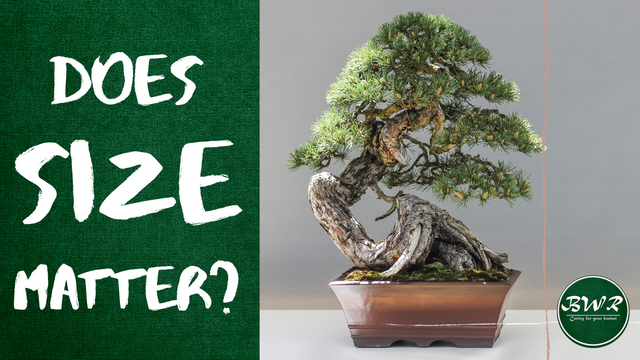Bonsai size classification: Does size matter?

On Tuesday I posted a photo on "Does size matter?" on my social media accounts trying to get a bit more interaction from my followers. Like any post you set out with a certain outcome in mind. I was surprised at the responses. There where a few that said the size of the bonsai does not matter and others that preferred large bonsai. Now before this turns into a mine is bigger than yours competition, let me explain why I chose this topic.
I see more and more during shows that people are not educated when it comes to bonsai sizes. Firstly its not just the public that does not know about the different sizes bonsai are classified in but the bonsai club members are just as confused. Below is a table with the size classifications of bonsai.

If you look at the table above you will most probability also be just as confused. Some of the classifications overlap and some have the same size range but there are two different common names for these classifications. I personally think that the inconsistency came when there was a shift from the way the Japanese classified sizes to how the rest of the world classified sizes. Trees were classified by how many people you required to carry them, but no we needed more clarification as the amount of people you needed to carry a tree was subjective.
Now that we have determined the sized of bonsai and how they are classified lets have a closer look at the common sizes of bonsai. As mentioned in my intro 75% of my followers on Instagram who voted said they prefer large sized bonsai and there was a grid lock when it came to does size matter as 50% of the voters on Twitter said is mattered and 50% said it does not. This is not surprising as this all boils down to personal preference. Here is a summary of how I see the three main classifications and where they fit in.
Miniature Bonsai
I find that miniature bonsai demand more attention. There pots are small thus they will require feeding and water more regularly. You will also need to either place them in a enclosure to ensure they do not dry out in between watering or you could place water under the bonsai to ensure they stay humid. The pots are difficult to find and many artist use self made pots or use other small objects to plant these miniature bonsai in. Because of the small size many of these bonsai do not have a large number of foliage on them. I have tried venturing down the miniature bonsai aisle and it did not end well for me. If you have the time and skill to work on these small specimens by all means go for it.
Medium-size Bonsai
Medium-sized bonsai are the most popular. They are small enough to carry around by yourself and their size allows you to add more detail in you design than with the miniature bonsai trees. The pots for these bonsai are available at all bonsai shops in different sizes and styles. Watering and feeding is not to difficult to manage. The bigger pots allow the trees to survive longer on the moisture in the soil mixture. You can apply more techniques to medium-size bonsai like wiring and grafting that can prove to be a bit more of a challenge in miniature bonsai. A big portion of my bonsai collection falls within this size range. If you are starting out this is the best place to start as you can either move up to large bonsai from here or down to miniature bonsai once you have the confidence and skill to work on medium-size bonsai.
Large Bonsai
In my opinion trees that fall in this range are mostly used as features in gardens. The size of these trees makes logistics slightly more interesting. Simple tasks like re-potting, taking you tree to a show or just moving your tree will require additional planning and man-power/women-power. Pots for these trees might be difficult to come by as styles and availability might be limited. Great care needs to be taken when watering and feeding due to the size of the pot. You might have to water the tree a few times before the entire soil mixture is moist. Working on a tree in this range can be very rewarding. Well refined large bonsai will look very impressive. One thing to keep in mind when you are thinking of working on these trees are the techniques you use as getting the right thickness of wire might be challenging. I have three trees that fall in the large bonsai range. If you like working on bonsai trees and you want to test your skills at a bigger scale well you in for a treat as large bonsai might be just the thing for you.
I have personally seen how many of our club member have scaled down from the large bonsai to medium-size bonsai as they age, travelling cost increase, time available to work on bonsai changes, water restrictions limit the ability to water bigger trees or their living conditions change. Before committing to bonsai please carefully consider you resources.
Thank you for taking the time to read my blog. Hope you enjoyed it. Please feel free to leave your questions and comments in the section provided below.
Before I leave you guys I thought it would be great to share this amazing opportunity with you guys that I came across.
Are you the type of person that likes your privacy and do not want anybody seeing what you are busy with online and tracking you every move. I have just the solution for you. Here is a screen shot I took earlier today to show you how much adds and trackers have been block as well as how much time I have saved since I have used this browser.

Download the Brave web browser:
https://brave.com/bon731
Not only does it protect your private data but you can get paid for using this internet browser just by watching the adds that you want. It’s really worth downloading and if you are a content creator like many of you are, you can get paid for your content by linking your sites to your brave rewards account.

 | This post have been upvoted by the @UpvoteBank service. Want to know more and receive "free" upvotes click here |